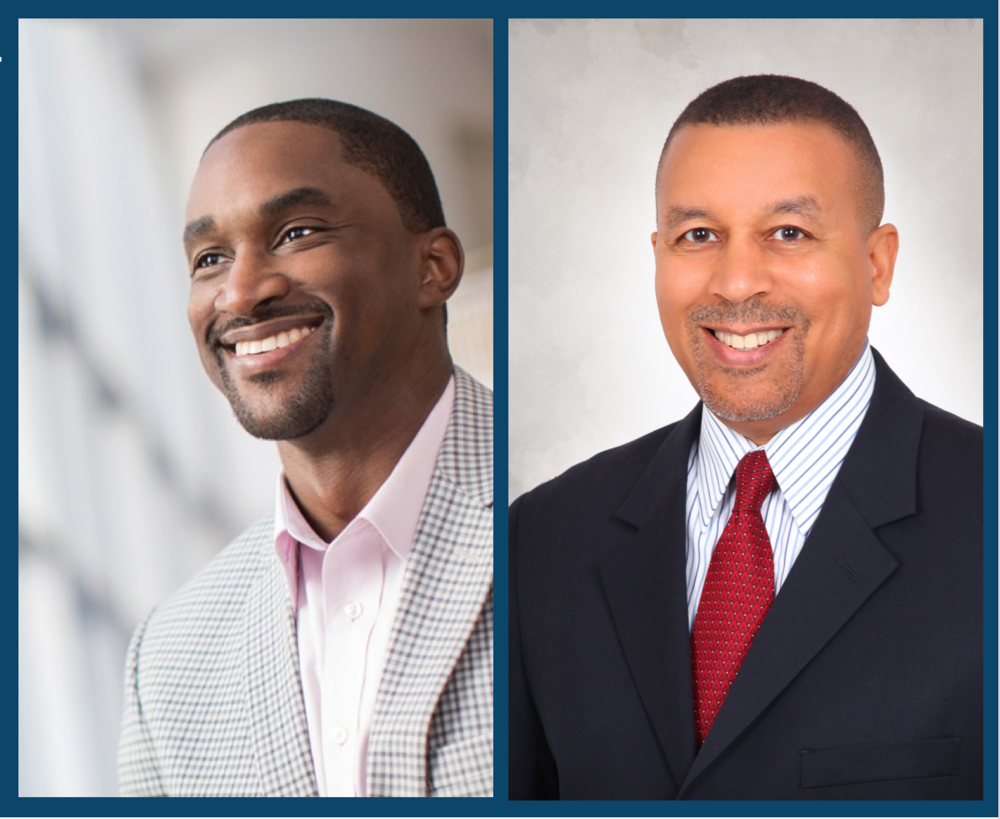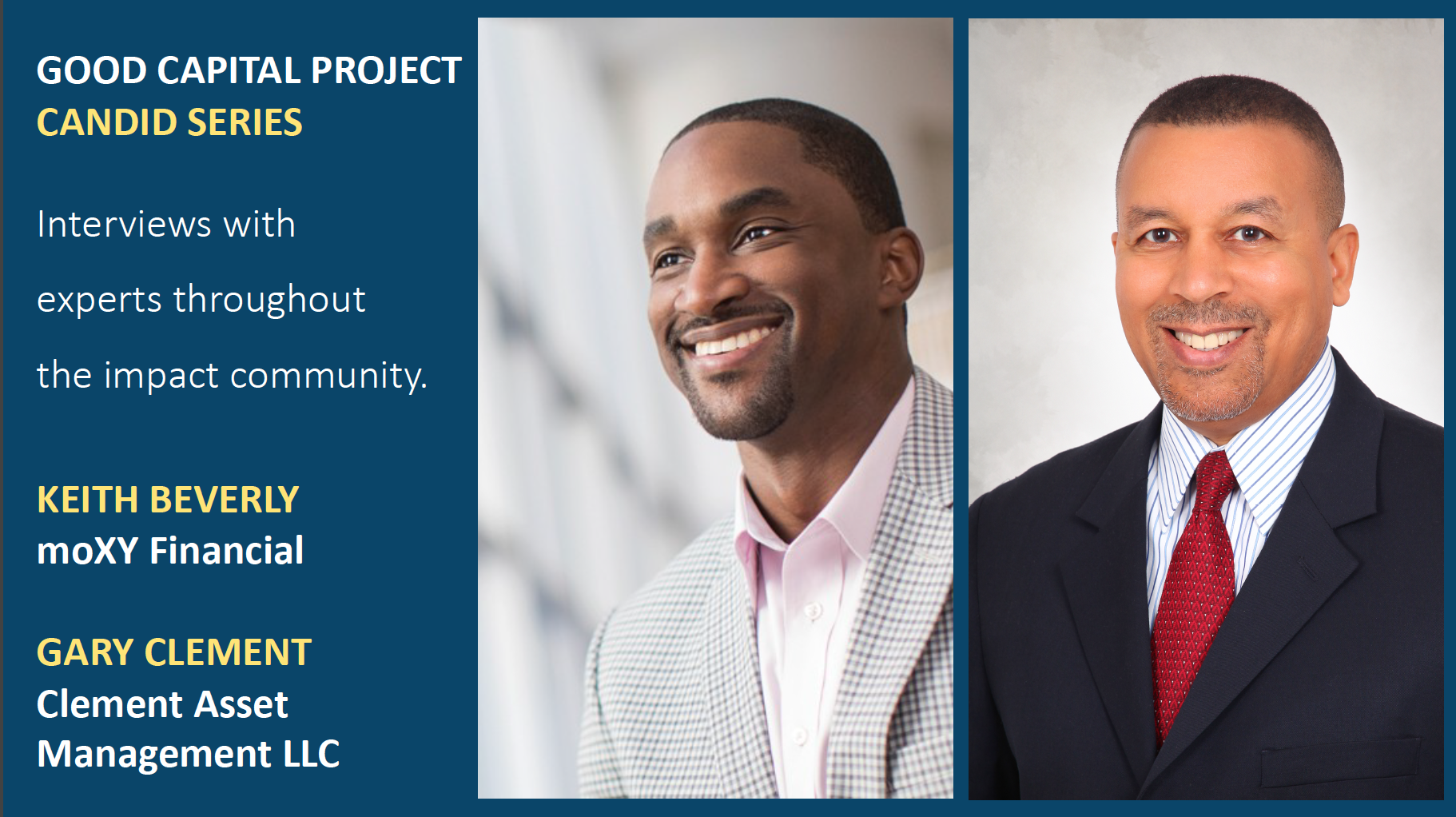
Keith Beverly, Founder, moXY Financial (Left)
Gary Clement, President, Clement Asset Management (Right)
Keith Beverly, Founder, moXY Financial, is committed to building an ecosystem that grows and transfers generational wealth. In speaking with numerous clients, he recognized the importance of a forum where overachievers committed to building significant wealth can discuss their ambitions to better society.
Gary Clement, President, Clement Asset Management LLC, is a lead instructor in the Kaplan Schweser Certified Financial Planning Program. He has been educating clients and helping them reach their financial goals since 1998.
Good Capital Project: Will you each give a brief description of your background, current work, and journey to impact?
Keith Beverly: My past has been focused more on the impact and investment side of things. I’ve worked in financial services since 2002 – either on the investment management side or financial planning. Starting in 2011, I began to focus more on working with individual clients ranging from 30 something-year-old tech entrepreneurs to 70 plus-year-old professors.
Recently in the financial sector, there have been more inquiries from clients regarding how they can align their investment portfolios with their personal values, missions, and principles. When my clients began to express interest in impact, I started looking into mission-aligned investments that I was not familiar with and compared how they performed relative to traditional portfolios. Eventually, I began looking at the role of diversity in my clients’ portfolios and giving them access to diverse wealth managers in public and private market investments.
Gary Clement: Although I’ve worked a lot in investment management, I only recently started working in impact investing. I have been in many different capacities as a client-facing advisor for over 20 years working with independent brokers and wirehouse organizations. Now I own an independent registered investment advisory firm, which is where I started looking at the opportunity and need for building clients’ assets in a way that will also meet their values.
GCP: As seasoned practitioners, what trends have you seen from firms and clients regarding the adoption of ESG and impact investing?
KB: Generally speaking, Wall Street and financial professionals are great at marketing. If they see a marketing opportunity, they will look to exploit it and produce more products that speak to the opportunity.
One takeaway I’ve observed recently is there’s an increasing amount of a focus on gender-lens investing. From my perspective, I think the next area that will start generating more interest are investments with a racial lens component.
When looking at data around gender-lens investing, a lot of the same theoretical concepts and data applies to racial-lens investing. So you could argue, the thesis supporting these investments are the same because you ultimately have a group of people being excluded in the investment process. However, diversity within company roles leads to better decision making, which will drive increased value for firms. The gist of this thesis applies to diverse communities, as well. Now, we’re starting to see the racial component enter into the equation. I believe we will see more traction in this area in upcoming years, but it’s encouraging to see gender-lens investing as a specific area of impact investing that caught on over the past 2-3 years.
GC: I agree 100% – I think that there’s a convergence happening within impact investing and companies are learning that this can be good for the bottom line. As the world changes, companies are realizing they need to change with the world, which is driving the impact world forward. Companies are placing a priority on operations that emphasize taking care of the environment, including different demographic groups, and building an understanding that the world is far more connected than ever before.
GCP: What is moXY Financial’s 20 by 2020 Initiative? Can you walk us through how this initiative got started and your approach to helping candidates obtain their CFP credentials?
KB: The 20 by 2020 initiative started 3 years ago. When we started this initiative, we didn’t know there were only 1.5% of Certified Financial Planners who identified as African-American. I was informally helping people within my network obtain the CFP designation and decided I wanted to be more active in how I addressed the issue. I decided that I wanted to help at least 20 African American advisors obtain their CFP credentials by the end of 2020, which in turn will increase the number of African-American CFP professionals by approximately 3%.
Last year, I connected with Gary, who has a distinguished teaching career working with over 7,000 students as they progress into taking the CFP exam. His efforts were very much aligned with my goals. In the middle of last year, we decided to combine our initiatives since we didn’t see the need to be redundant and stay in our individual silos. Since we’ve combined efforts, we have developed more structure around the program. To date, we have worked with ten CFP candidates, four of whom just sat for the most recent exam. We don’t know the results of the students who took the exam recently, but of the other six students – four passed the exam and have seen their career prospects significantly improve. It’s great to see the months of hard work they put in working with us has paid off.
GC: To be clear, moXY Financial’s 20 by 20 Initiative is not a substitute for an education or review program. Our initiative exists somewhere at the end of the education program and the test day. We encourage our participants to attend a board certified education program or review classes for taking the CFP exam. This initiative is about creating a space in which students have the ability to hold each other accountable, create a network to help them study, and properly prepare for the exam. Our goal is to set up a scenario where the students can receive coaching and mentorship around the exam topics from folks who are seasoned professionals. We are well on our way to reaching 20 students and will probably exceed our goal by the end of 2020.
GCP: What are some of the other ways that we can address this systemic problem of underrepresented advisors of color?
KB: Last week I came back from a conference in Washington D.C. and there were CEOs of very large RIAs who had $30 billion in assets between them. Each CEO spent an hour discussing a topic, and not once did the topic of race come up. When you look at the RIA space, the RIA channel has captured market share and grown steadily over the past decade. However, advisors of color in client-facing roles are essentially nonexistent with less than 1% of advisor roles at large, independent RIAs. There’s clearly a huge disconnect, especially when you consider the fact that 43% of millennials are people of color. I see a lack of diversity as a tremendous risk that is not on the radar of a lot of RIAs, but it should be. If these companies don’t change over the next decade, they will end up losing ground to some of the larger banks who have dedicated diversity teams.
Another way to address this problem is in the municipal space around fiscal justice. Essentially, this refers to many municipalities that consistently issue fines and fees predominantly affecting people of color and low-income communities. I am currently working on a strategy looking to quantify this phenomenon and effectively price it from a risk perspective at a municipal bond market. The ultimate goal is to hold counties and governments responsible for the work they are doing. We should be aware of unfair and unsustainable practices being used against our most vulnerable communities – and there should be a financial penalty for those practices.
GC: Another way we can address this problem is by developing a pool of qualified people who can plug into CFP positions as they become available. With moXY 2020, we’re providing people with the necessary knowledge, networks, and mentoring to qualify for positions in financial services. We recognize that many students coming out of college programs are not well equipped to jump into a position as a client-facing advisor. But, there are steps that can be taken to help young people coming into this industry prepare for those roles. We need to increase the number of programs that prepare kids of color in high school and college to be interested in a financial career path. I believe this will help more young people from diverse backgrounds to see the wonderful opportunities that may be available in working in finance while preparing them to actually work in this industry.
Another way I have been working on this problem is through HBCUs, which goes hand-in-hand with what we’ve been discussing. There are currently 380 programs for board certified CFP courses – only 3 of them are housed at HBCUs. HBCUs are in a unique position because they can implement programs that meet the needs of businesses and graduates coming into the business world. Innovative CFP programs should be offered at more HBCUs because if an RIA is looking for diverse talent, they should be able to turn to schools offering these programs and access to diverse candidates. If we can offer programs that gear students towards financial services while providing them with a strong financial knowledge base, we will be able to give them a huge leg up in their careers and impact diversity simultaneously.




